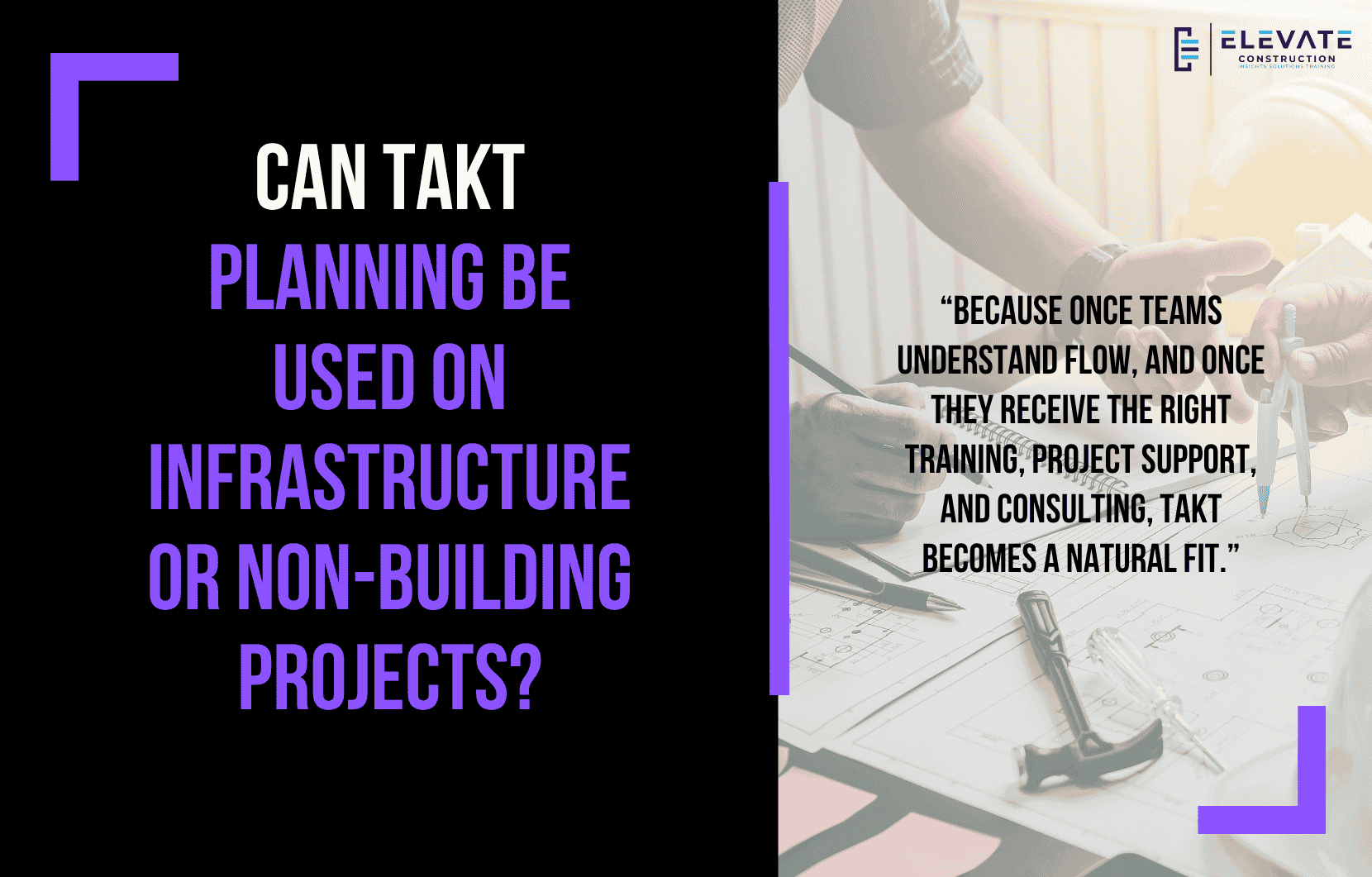Can Takt Planning Be Used on Infrastructure or Non-Building Projects?
Absolutely, And We Train Teams How to Do It.
When most people hear “Takt Planning,” they picture a high-rise building neatly divided into identical zones, each flowing in rhythm from trade to trade. And yes, vertical construction was one of the earliest environments to adopt Takt. But limiting Takt to buildings leaves enormous value on the table.
Over the past several years, our team has helped companies apply Takt principles across infrastructure, industrial, heavy civil, and non-building projects through professional training, project support, and consulting. The results have been remarkably consistent: smoother handoffs, predictable production, safer sites, and better use of crews and equipment even on projects that look nothing like a typical floor-by-floor build.
So yes, Takt Planning absolutely works for infrastructure.
And with the right training and support, your teams can implement it confidently and quickly.
Why Takt Works on Infrastructure and Why Training Matters
Takt Planning simply means:
- Breaking work into repeatable, value-adding tasks.
- Sequencing those tasks into a continuous flow.
- Balancing crew sizes and durations.
- Creating predictable, stable production.
Through our Takt training programs, construction leaders learn how to break down any type of project into repeatable, flow-based sequences.
This is where our work density analysis method becomes essential. Once you understand how to size zones by time, not distance or geometry, Takt Planning becomes universally applicable, roads, utilities, plants, rail systems, industrial facilities, and more.
The Mindset Shift: Rethinking Zones in Infrastructure
In buildings, zones are obvious, rooms, floors, wings.
In infrastructure, our consulting team helps clients rethink zones using:
- Geographic boundaries.
- Traffic control sections.
- Environmental or permit-driven limits.
- Equipment spreads or radii.
- Work-type sequences.
- Stationing in linear infrastructure.
When teams learn this through our hands-on Takt training, zone creation becomes intuitive.
When they apply it through our project support services, flow becomes predictable.
Examples of Takt Planning on Non-Building Projects
Below are common patterns we help teams implement through consulting and project support:
- Roadway & Highway Projects
- Typical Takt structure: 300–500 ft zones.
- Flow includes subgrade → utilities → base → pavement → guardrail → striping
- With Takt coaching, crews stop tripping over one another and production stabilizes.
- Pipelines & Utility Corridors
- Flow: trench → lay → weld/fuse → inspect → backfill → restore
- Takt significantly reduces gaps between trenching and installation crews.
- Treatment Plants & Industrial Facilities
- Even though these aren’t linear, they contain process units that behave like zones.
- With proper facilitation, mechanical and electrical teams flow without crowding.
- Bridges & Structural Infrastructure
- Zone by span or pier group
- Trade flow includes rebar, formwork, concrete placement, steel erection, and coatings.
Why Infrastructure Teams Benefit Even More from Takt
Our clients in civil and industrial markets see massive improvements because their projects:
- Stretch across long distances.
- Depend heavily on equipment coordination.
- Require precise access and phasing.
- Operate under strict environmental controls.
- Have dozens of agencies, inspectors, or utilities involved.
Teams that receive Takt Planning training or project support commonly report:
- Reduced idle equipment time.
- High crew utilization rates.
- Safer, more predictable work areas.
- Better sequencing for traffic control.
- Reduced rework.
- Clear communication between GC, subcontractors, and inspectors
- And when supported by experienced Takt consultants, they maintain the system long-term.
Challenges We Commonly Solve Through Training & Coaching
- Non-Uniform Work Areas
We train teams to use work density analysis to size zones by effort, not feet/meters.
- Weather & Environmental Constraints
We teach buffer strategies and release mechanisms to protect the flow.
- Variable Site Conditions
Our project support teams help establish a pilot zone, stabilize production, and scale the plan.
- Mindset Barriers
Through visual training and on-site coaching, teams finally “see” the flow and buy in. Yes, Takt Absolutely Works for Infrastructure.
And We Can Train Your Team to Do It.
In fact, some of the most dramatic Takt wins we’ve seen didn’t happen in buildings, they happened in:
- Roads and highways.
- Pipelines and utilities.
- Rail and transit systems.
- Water and wastewater plants.
- Industrial complexes.
- Renewable energy installations.
- Distributed infrastructure and civil projects.
Because once teams understand flow and once, they receive the right training, project support, and consulting, Takt becomes a natural fit.
If your project requires coordination, sequencing, and predictable production, Takt will elevate your team.
If you want to learn more we have:
-Takt Virtual Training: (Click here)
-Check out our Youtube channel for more info: (Click here)
-Listen to the Elevate Construction podcast: (Click here)
-Check out our training programs and certifications: (Click here)
-The Takt Book: (Click here)
Discover Jason’s Expertise:
Meet Jason Schroeder, the driving force behind Elevate Construction IST. As the company’s owner and principal consultant, he’s dedicated to taking construction to new heights. With a wealth of industry experience, he’s crafted the Field Engineer Boot Camp and Superintendent Boot Camp – intensive training programs engineered to cultivate top-tier leaders capable of steering their teams towards success. Jason’s vision? To expand his training initiatives across the nation, empowering construction firms to soar to unprecedented levels of excellence.
On we go

